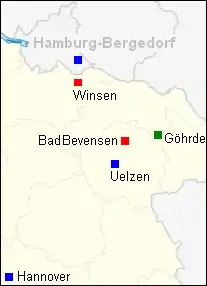Göhrde murders
The Göhrde murders in the Göhrde State Forest in Lower Saxony were two double murders, which in the summer of 1989 caused a sensation throughout Western Germany and today are regarded as spectacular criminal cases. Within a few weeks, two couples in the same forest area of the Göhrde were murdered, probably by the same perpetrator. The second double murder took place while the Kriminalpolizei (Criminal Investigation Department) were only a few hundred metres away, securing forensic identification of the first crime. The forest area was then avoided by walkers and excursionists for almost 30 years, and the cases remain unexplained.
At the end of December 2017, the Lower Saxony Police announced that they had already determined that the cemetery gardener Kurt-Werner Wichmann, who had committed suicide in 1993, was a high-risk perpetrator, who was probably a serial killer who had committed further murders. This was achieved with the result of a DNA test of two hairs. The investigators also suspect another previously unknown person to be linked to the killings (and possibly other deeds) as an accomplice.[1][2]
Location and weather
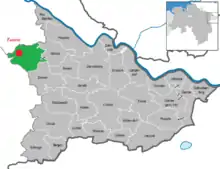
Location of the Göhrde and the crime scene
The Göhrde is an about 75 square kilometres large state forest in the Lüchow-Dannenberg district and to a small extent in the Lüneberg district. Both districts are located in the northeastern region of the federal state of Lower Saxony, about 60 kilometres away from Hamburg, 30 kilometres from Lüneburg and 20 kilometres from Uelzen. The Göhrde is the largest mixed forest in Northern Germany and is almost uninhabited. It used to be the hunting ground of the dukes of Brunswick and Lüneberg, which at the beginning of the 18th century the Jadgschloss Göhrde housing area was established. Later, the kings of Hanover and the German emperor went hunting there. In 1989, the Göhrde was still in the largely uninhabited former east-west German border area.
The two crime scenes (first and second double murders) are located near the B 216 road in the forest hunting sections 138 and 147.[3]
Weather and temperatures
In the summer of 1989 there was a prolonged heatwave, as it had been for years. It was dry for weeks, so traces were not destroyed by weather condictions such as rain, hail or storms. On the other hand, it was exceptionally hot for a long time, which greatly accelerated the bodies' mummification process.
Murders
First double murder
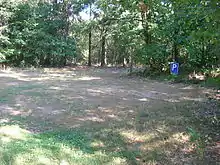
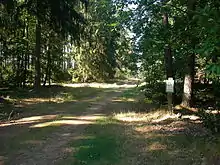
On May 21, 1989, Ursula and Peter Reinold from Bergedorf drove to the Göhrde to go for a walk there. It is believed that the 45-year-old woman and her 51-year-old husband went to a glade in hunting sector 147 to sunbathe or have a picnic. They were killed on the spot, but were not left at the crime scene. The culprit took his victims to a nearby depression in the land and hid them there. The victims were undressed, although it is unclear if they were undressed before the murder or the murderer had undressed them himself. The offender then stole the victims' picnic basket and took the car keys. The perpetrator then left the Göhrde with their car which he abandoned 300 meters away from the train station in Winsen an der Luhe, a small town in the Hamburg region. The couple had meanwhile been reported missing. Seven weeks later on July 12, 1989, the bodies were discovered by three blueberry collectors. The bodies were in a state of advanced decomposition due to the high temperature at the time, mummified, and largely skeletized.[4]
The three blueberry collectors went to the forester to let the police know. On the way, they met a brown-haired, well-built man, about 40 years old with a bag in his hand. The Kriminalpolizei assumes that this was the perpetrator, who was already seeking more victims in the Göhrde at the same time.
Due to the condition of the two corpses the exact cause of death could not be explained either at the crime scene or at the later autopsy. However, it was clear that was not suicide or an accident, and that a crime had been committed and shooting, strangling or slaying were considered possible causes. The husband had an injury to his larynx. However, it could not be determined whether it was from strangulation or an injury from being trampled by a wild boar.
Second double murder
On July 12, 1989, the day of the discovery of the second murder, the 46-year-old housewife Ingrid Warmbier from Uelzen and a 43-year-old district manager of the Toto-Lotto Society, Bernd-Michael Köpping from Hanover, drove together to the Göhrde. They were lovers who came after lunch from nearby Bad Bevensen and apparently made a trip. Both were otherwise married, and their respective spouses did not know about their relationship. They parked in a small side street near the Forsthaus Röthen and walked more than two kilometers into the forest.In the hunting sector 138, they met the perpetrator, who apparently threatened them with a firearm and tied their hands and feet partially with a Leucoplast band. Both had to lie face down. The offender strangled the male victim and killed him with a headshot from a 5.6mm small caliber weapon. The woman had her skull smashed and received heavy chest injuries. Her blouse was at the level of the bra and the bra was cut. They were both shot in the head. He then stole the male victim's Polaroid camera and the keys to his Toyota car, with which he departed from the Göhrde. Further investigation revealed that the perpetrator used this vehicle for about a week before he parked it in the vicinity of the spa clinic in Bad Bevensen.
Two weeks later, on July 27, 1989, police officers taking part in the nationwide search for clues discovered the victims of the second double murder by chance. The date of death could certainly be dated July 12, 1989, the day the police began their investigation into the location of the first murdered couple. The scene was located 800 meters from the site of the first double murder. According to the investigators' reconstructions, the perpetrator committed the second double murder at a time when the Kriminalpolizei were at the scene of the first two victims and had just begun their investigation. Subsequent tests revealed that despite the close range, shots could not be heard because both sites of the bodies of the first double murder and the scene of the second double murder were in depressions in the land.
Parallels
The parallels between the two crimes were that a middle-aged couple was murdered each time and both crime scenes were in the same area of the huge forest. in both cases the offender stole victims' conspicuous technical items, although the investigation was not a classic robbery. The perpetrator took both victims' cars to depart from the Göhrd, abandoning the vehicles in small towns with railway connections. Both towns are located on the Hanover-Hamburg railway, and these parallels prompted the investigators to believe that the perpetrator was the same. It is believed that he disposed of the items he had taken following the high public interest raised by the two double murders.[5]
Aftermath
The two double murders had significant consequences for the Göhrde. In the press and on television, the forest was designated 'dead woods'. Walkers and day-trippers were afraid and avoided the forest for many years.
Investigations
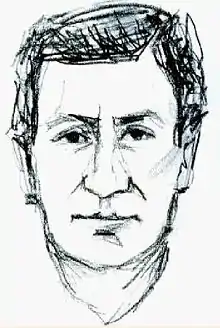
Measures
immediately following the discovery of the first crime the Lower Saxony police formed a special 40-member commission with the detectives from the region and Lüneberg. The commission's appeal created 1,911 records and approximately 10,000 people were interviewed . A facial composite was created and published with a reward of 50,000 Deutsche Mark. In December 1989 and again in January 1990, the case was broadcast in the television series Aktenzeichen XY … ungelöst (a cold case programme) but it did not lead to success.
As a result of further investigations by police profilers the perpetrator was characterized as "brutal, aggressive, emotionally cold, a loner, sexually disturbed, mentally ill, choleric, overcorrect" and "introverted". The investigators assumed that he had been a non-smoker, that he could organise his own time and would be not have missed a day from work.
The examinations of a number of persons, for example patients of the closed psychiatry who had were on parole at the time of the crime, as well as the guests of inns, hotels and spas in nearby Bad Bevensen did not provide new leads. Likewise, no clues were drawn from the review of all vehicle owners from license plates recorded in the area at the time. Also, the later identified Kurt-Werner Wichmann was checked. He was suspected due to his criminal record and was on sick leave at the time of the double murder (he also did not have to work at the time of the first murder on a Sunday).[6] One witness saw him, but because he had worn glasses, he claimed that Wichmann did not match the facial composite.
Also suspected was the husband of the victim in the second double murder, a baker. It was theorized that he had hired somebody to kill his unfaithful wife and lover, and that the hitman accidentally got the wrong couple first.[7]
First "clue"
After a short time there was an apparent clue. In Wales, a similar double homicide had occurred in June 1989 for which 64-year-old John Cooper was later arrested in May 2009, found guilty, and sentenced to life imprisonment.[8] [9][10] The Dixon couple were on a camping trip in when they were shot at close range at Little Haven. The corpses were found away from the road, with the husband's hands tied behind his back. Witnesses had noticed a day before the double murders a 40-year-old man whose description was similar to that of the alleged Göhrde murderer. The witnesses also reported a companion of about 20 years of age with a German or Dutch accent. In the Göhrde, police had found a Dutch coin near the first scene. The crime scenes in Germany and Wales were both near UK military training grounds. No connection between the Göhrde Murders and Cooper has been made.
Second "clue"
In 1993, a witness had heard a man threaten his wife during a quarrel that she should not forget the Göhrde murders and that she might go the same way if she continues to cheat on him. The witness reported their observations to the police. The first superficial review was promising, because the suspect had a firearms permit for a small caliber 5.6mm weapon. With such a weapon, the male victim of the second double murder had been shot. In addition, the appearance of the suspect matched the brown hair and size, of the prepared facial composite. Finally, the suspect came from the area and had local knowledge as a forester. The local knowledge was important for a crime in such a remote area. After several months of further investigation, a search warrant was obtained by the police and the forester's house was searched and the weapons were seized. Many hours of hours of interrogation of the suspect and his wife did not lead to success as there were no incriminating circumstances and the suspect had an alibi for the second double murder.
Further development
The special commission was later dissolved, as it did not find the culprit. The head of the special commission retired in 1997. After that, only two detectives from the former special commission sporadically worked on the case, namely an investigator from Lüchow and an investigator from Lüneberg. In 2009, only the detective from Lüneberg was delegated follow up on any occasional hints.
In July 2009, there was another, possibly last investigation approach: after the two hairs were secured in the vehicle of one of the victim pairs (the Reinolds), which were neither assigned to the victims nor the environment. The Kriminalpolizei now wanted to carry out a new DNA test using more modern methods and compare them with the data stored in the Federal Criminal Police Office records. The problem of DNA analysis was that the DNA pattern in old, failed, rootless hairs can only be completely isolated with a 60 percent probability.[11] The criminal investigation was still on the assumption that the two hairs were suitable to identify the perpetrators.[12] In 2014, however, it was stated that the case would not be reopened to capacity reasons.[13] In June 2017 it was announced that a DNA result linked to the crime scene of a murder in Hanover in 2015.[14] However, because of another murder and the conviction of a 27-year-old man named Leger, no traces were confirmed.[15]
Links to the murder of Birgit Meier
Decisive evidence for the identification of the perpetrator of the Göhrde murders emerged from the case of 41-year-old Birgit Meier from Lüneberg who disappeared without a trace in 1989, shortly after she separated from her husband, and the police suspected murder. On May 15, 1989, the day of her disappearance, she had an appointment with her lawyer for the sale of her house in Brietlingen and had been happy the day before, with her mother on the phone about being able to move soon.[16] Suicide or the husband were initially suspected, but later investigations on the Lüneberg graveyard gardner focused on Kurt-Werner Wichmann, whom the disappeared had previously met at a party, according to the ex-husband's statements.[17] He had previously done gardening work for Meier's neighbours. As early as 1989, there were suspicions against Wichmann in the case of Birgit Meier and he was interrogated, but his alleged alibi was not examined closely. He concealed the fact that he was on sick leave at the time of Meier's disappearance and the police did not research thoroughly. Following the appointment of a new prosecutor in Lüneberg new investigations were begun. In 1993, the gardener was charged with the murder of Meier and the police raided his house. The investigators found two small caliber rifles, a converted gas pistol, stun guns, a silencer, handcuffs, sedatives and sleeping pills, including a secret soundproof torture room that only he and his brother were allowed to enter. A bright red Ford sports coupe was found buried in the backyard, with blood on the backseat but no bodies were found.
Kurt-Werner Wichmann fled from the search. He was arrested in the Germa state of Hesse when he was involved in a traffic accident and weapons were found in his vehicle. In the vehicle was his 10 years younger brother, who was dominated by Wichmann.[18] Ten days after his arrest, the 43-year-old hanged himself in prison. He had attempted suicide before. He left strange farewell letters in which he asked, among other things, for his brother to "clean the gutter". After his death, the murder series suddenly stopped, and further investigations against him were discontinued. His vehicle and items were disposed of by the authorities.
Private investigation
Investigations into the Göhrde murders were resumed due to the initiative of Birgit Meier's brother Wolfgang Sielaff, the retired former chief of the State Criminal Police of Hamburg. In 2002 following his retirement he began his own private investigation and formed a team with the head of forensic medicine in Hamburg, Klaus Püschel, the defense lawyer Gerhard Strate, and other professionals.[19] In 2013, during a search in a room belonging to Wichmann, Sielaff found videotapes from the Aktenzeichen XY TV episode on the Göhrde murders and newspaper clippings related to it. In 2015 was able to have a new special commission set up by the Lüneberg police, which investigated the case of Birgit Meier.[20] In 2016, handcuffs related to the case were found stored at the Hannover Medical School that had missed being disposed of by the police. On examination, traces of blood were found on them that showed a DNA match with the missing persons. Sielaff also received permission from the new owner of Wichmann's former garage in Bardowick to carry out excavations there.[21][22] Wichmann's house had been searched in 1993 by the Lüneberg police several times in vain, once even with sniffer dogs.[23] According to the presumptions of the investigators, Wichmann wanted to kidnap Meier to extort money from her husband, but failed.
Identification of the offender
In December 2017, 28 years after the killings, the Lower Saxony police announced that they consider the former cemetery gardener Kurt-Werner Wichmann for the Göhrde Murders for highly probable as guilty and that a new investigation had begun. A trace of Wichmann's DNA was found In one of the stolen victims' vehicles was found and according to the police, this was a separate lead from the hair that had been examined years before.[24] The police assume the existence of an accomplice who may have committed other crimes. The essential clue for a second person involved in the case is derived from the fact that Kurt-Werner Wichmann had driven into the Göhrde with his own vehicle, but returned with the vehicles of the murder victims It remained unclear how he recovered his own car. According to Sielaff's findings, there were 21 unsolved murder cases in Lüneberg and the surrounding areas which could be attributed to Wichmann by the perpetrator profile and their respective whereabouts. Possibly, according to the assessments of the police, Wichmann committed murders in other areas. After his release from prison in 1975, he spent three years in Karlsruhe, where he lived with an elderly woman whom he had met through a personal advert during his detention. During this time, there were several unsolved murders of hitchhikers in Karlsruhe.[25] Wichmann was very mobile and had five cars.
On January 19, 2018, following a post-mortem, it was announced by the Hannover Medical School that Birgit Meier had been shot.[26] The Lüneberg Police President Robert Kruse said it could have been a serial killer who has killed abroad.[27] He announced a thorough review of old cases, which could pinpoint Wichmann as a perpetrator. As a result, analysts from the State Criminal Police Office of Lower Saxony have filtered 24 unsolved cases, in particular homicides and missing persons. In February 2018, the case was again featured in Aktenzeichen XY.. ungelost on television, as the investigators suspect the existence of an accomplice.[28]
In 2018, using sniffer dogs and metal detectors, the police and 30 detectives searched Wichmann's former house and grounds for more than two weeks.[29] Approximately 400 items were secured, which are investigated by the State Office of Criminal Investigation of Lower Saxony on connections with other murders.[30] These include a Polaroid camera and binoculars, which may have belonged to the murdered Reinolds.[31][32]
In the autumn of 2018, a suitcase appeared that had been lying in an attic in an industrial area in Lüneburg for years, containing two firearms with ammunition and a driver's license in the name of Wichmann issued in Karlsruhe in 1976. The suitcase was taken by the Lüneburg used car dealer Michael Volkert to the Landeszeitung für die Lüneburger Heide, a regional daily newspaper, which in turn handed it over to the police. The used car dealer had probably received this from his friend Hans Rudloff, the husband of Wichmann's widow - after he had already granted Sielaff access to Wichmann's former house. Rudloff died in early 2017. [33] [34] [35]
TV series
German TV Das Erste has shown three parts of Das Geheimnis des Totenwaldes ('Mystery of the Death Forests') based on the murders and also replayed three documentaries Eiskalte Spur – Die Göhrde-Morde und die verschwundene Frau ('Cold trace - The Göhrde murders and the lost woman').[36] [37] Both the fiction and documentary inform that according to German law, the death of a suspect closes the investigation, which explains the above statement "further investigations against him were discontinued".
External links
- Case report (Video) in the program Aktenzeichen XY … ungelöst from December 1, 1989
- Göhrde murders: Hope hangs on two hairs. Report from NDR from May 20, 2014
- The big mystery of the „Göhrde Murders“, Hamburger Abendblatt Online of May 20, 2014
- Meet the phantom: 25 years ago, the Göhrde murderer struck. wendland-net on May 21, 2014.
- Meeting of the Lüchow-Dannenberg Local History Working Group on the Göhrde murders - Legal practitioners call for investigations to be carried out. wendland-net on October 16, 2014.
- Why did Birgit Meier die? at zeit.de on April 24, 2018
References
- Lüneburg: Göhrde-Doppelmorde nach 28 Jahren aufgeklärt in Spiegel Online vom 27.
- Pressemitteilung der Polizeidirektion Lüneburg vom 27.
- Jürgs, Michael (7 August 2018). "Der Fall seines Lebens" – via Sueddeutsche.de.
- Michael Jürgs (1996), "Das Phantom der Göhrde", Der Spiegel, 9 September 1996 (37), p. 133
- Zand-Vakili, André (14 July 2009). "Bluttaten: Zwei Haare sollen zum Göhrde-Mörder führen" – via www.welt.de.
- Kunze, Rohrbeck, Auf der Lichtung, Zeit Online, 31.
- Anne Kunze, Felix Rohrbeck, Auf der Lichtung, Zeit Online, 3.
- "Archived copy". Archived from the original on 2012-07-30. Retrieved 2020-01-06.CS1 maint: archived copy as title (link)
- "Cooper pleads not guilty to double murders". Western Telegraph.
- WalesOnline (26 May 2011). "John Cooper found GUILTY of Pembrokeshire double murders". walesonline.co.uk.
- Hamburg, Hamburger Abendblatt -. "Polizei jagt Vierfachmörder in Norddeutschland". abendblatt.de.
- Polizei sucht 25 Jahre nach Göhrde-Morden weiter nach dem Täter.
- Elbe-Jeetzel-Zeitung. "Göhrde-Morde werden nicht neu aufgerollt". Elbe-Jeetzel-ZeitungElbe-Jeetzel-Zeitung.
- NDR. "Nachrichten aus Lüneburger Heide und Unterelbe-Region". ndr.de.
- Tobias Morchner: Gibt es eine Wende bei den Göhrde-Morden?
- So lebte Serienkiller Kurt W.: Zu Besuch im Grusel-Haus So lebte Serienkiller Kurt W., Berliner Kurier, 30.
- Anne Kunze, Felix Rohrbeck (2016-10-20). "Serienmord: Warum starb Birgit Meier?". Die Zeit. Retrieved 2017-12-28.
- "Serienmord: Hatte der Göhrde-Mörder einen Gehilfen?". zeit.de.
- Carlo Eggeling, Gabriele Schulte: Endlich Gewißheit für die Familien.
- Kunze, Rohrbeck, Warum starb Birgit Meier ?, Zeit Online, 25.
- "Gewissheit: Tote Birgit M. identifiziert". ndr.de. 2017-07-24. Retrieved 2017-12-29.
- Matthias Rebaschus (2017-12-28). "Kurt-Werner Wichmann: War er ein Serienmörder?". Die Zeit. Retrieved 2017-12-28.
- Sebastian Eder: Göhrde Morde aufgeklärt, der Gärtner wars.
- ""Göhrde-Morde": Täter ermittelt, Fragen bleiben". NDR. Retrieved 2017-12-28.
- Anne Kunze, Felix Rohrbeck, Mörderischer Liebling, Zeit Online, 27.
- Gutachten der MHH: Birgit M. wurde erschossen bei ndr.de vom 19.
- Online, FOCUS. "Lüneburg: 1989 verschwundene Birgit Meier vermutlich erschossen". focus.de.
- Polizei sucht weiter Mitwisser der Göhrde-Morde bei ndr.de vom 2.
- "Göhrde-Morde": Polizei überprüft neue Spuren bei ndr.de vom 11.
- "Göhrde-Morde": 400 Fundstücke sichergestellt bei ndr.de vom 20.
- Polizei findet neue Spuren zu Göhrde-Morden bei ndr.de vom 11.
- Der Spiegel, Nr. 24, 2018, S. 21
- „Göhrde-Morde“: Neue Beweise aufgetaucht?, NDR.de, 18. Oktober 2018
- Schaumburger Nachrichten (18.10.2018): Neue Beweismittel im Fall des Göhrde-Mörders aufgetaucht
- Express (19.10.2018): Rätsel-Fall von 1989. Mysteriöser Koffer bringt spektakuläre Wende in Mord-Serie
